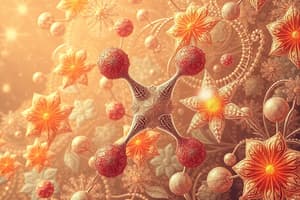Podcast
Questions and Answers
What is the significance of the geometry of π– bonds in allenes?
What is the significance of the geometry of π– bonds in allenes?
It causes the groups attached to be in perpendicular planes
What causes a molecule to be chiral?
What causes a molecule to be chiral?
Having non-superimposable mirror images
Why is penta-2,3-diene considered a chiral molecule?
Why is penta-2,3-diene considered a chiral molecule?
It has no chiral centers but has non-superimposable mirror images
Why do allenes with different substituents on the end atoms exhibit chirality?
Why do allenes with different substituents on the end atoms exhibit chirality?
What is an example of a chiral molecule with two stereocenters but no chiral centers?
What is an example of a chiral molecule with two stereocenters but no chiral centers?
How are the pi-bonds in allenes oriented with respect to each other?
How are the pi-bonds in allenes oriented with respect to each other?
What is the essential requirement for keto-enol tautomerism to occur?
What is the essential requirement for keto-enol tautomerism to occur?
Why do benzaldehyde and benzophenone not show keto-enol tautomerism?
Why do benzaldehyde and benzophenone not show keto-enol tautomerism?
What are the products formed by the keto-form of a compound containing a carbonyl group?
What are the products formed by the keto-form of a compound containing a carbonyl group?
What is the difference between E-form and Z-form in terms of the arrangement of groups around a double bond?
What is the difference between E-form and Z-form in terms of the arrangement of groups around a double bond?
How can you calculate the percentage Enantiomeric Excess?
How can you calculate the percentage Enantiomeric Excess?
How can the enolic form of a compound be detected?
How can the enolic form of a compound be detected?
In Allenes, why are the groups attached to the end carbon atoms in perpendicular planes?
In Allenes, why are the groups attached to the end carbon atoms in perpendicular planes?
What makes allenes with different substituents on the end carbon atoms chiral?
What makes allenes with different substituents on the end carbon atoms chiral?
What conditions give rise to optical activity in Biphenyl Compounds?
What conditions give rise to optical activity in Biphenyl Compounds?
What happens to the enolic form of a compound in Br2/CCl4 solution?
What happens to the enolic form of a compound in Br2/CCl4 solution?
How does the presence of large substituent groups at the o and o’-positions in Biphenyl Compounds affect the molecule's optical activity?
How does the presence of large substituent groups at the o and o’-positions in Biphenyl Compounds affect the molecule's optical activity?
Flashcards are hidden until you start studying
Study Notes
E-Z Isomerism
- E-form: When two same priority groups are present on the opposite side of a double bond, it is known as the E-form.
- Z-form: When two same priority groups are present on the same side of a double bond, it is known as the Z-form.
Racemic Forms and Enantiomeric Excess
- Enantiomeric excess (%) = ((moles of one enantiomer - moles of other enantiomer) / total moles of both enantiomers) * 100
- Specific rotation (θ) = (observed specific rotation / specific rotation of the pure enantiomer) * 100
Optical Activity in Allenes
- The planes of π-bonds of allenes are perpendicular to each other.
- This geometry causes the groups attached to the end C atoms to lie in perpendicular planes.
- Allenes with different substituents on the end C atoms are chiral.
Optical Activity of Biphenyl Compounds
- When at least three of the 2,2’,6, and 6’ positions are occupied by sufficiently large groups, free rotation about the single bond joining the two phenyl groups is restricted.
- This restricted rotation gives rise to optical activity due to the molecule being asymmetrical as a whole.
Allenes with Chiral Centers
- Allenes with different substituents on the end C atoms are chiral.
- Such allenes do not show cis-trans isomerism.
- An example is penta-2,3-diene, which has no chiral centers but is a chiral molecule with two enantiomers.
Keto-Enol Tautomersm
- Keto-enol tautomerism occurs in compounds with α-hydrogen atoms.
- Examples of compounds that exhibit keto-enol tautomerism include butan-2-one and acetophenone.
- Examples of compounds that do not exhibit keto-enol tautomerism include benzaldehyde and benzophenone due to the absence of α-hydrogen atoms.
- Keto-forms form oximes, hydrazones, and give a positive DNP test.
- Enolic-forms give a color with neutral FeCl3 solution, decolourise Br2/CCl4 solution, and form acetyl derivatives.
Studying That Suits You
Use AI to generate personalized quizzes and flashcards to suit your learning preferences.




